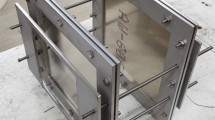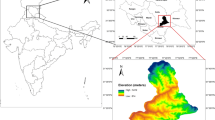Abstract
It is always a challenging task to model the trajectory and make an efficient damage estimation of debris clouds produced by hypervelocity impact (HVI) on thin-plates due to the difficulty in obtaining high-quality fragment images from experiments. To improve the damage estimation accuracy of HVIs on a typical double-plate Whipple shield configuration, we investigate the distributive characteristic of debris clouds in successive shadowgraphs using image processing techniques and traditional numerical methods. The aim is to extract the target movement parameters of a debris cloud from the acquired shadowgraphs using image processing techniques and construct a trajectory model to estimate the damage with desirable performance. In HVI experiments, eight successive frames of fragment shadowgraphs are derived from a hypervelocity sequence laser shadowgraph imager, and four representative frames are selected to facilitate the subsequent feature analysis. Then, using image processing techniques, such as denoising and segmentation techniques, special fragment features are extracted from successive images. Based on the extracted information, image matching of debris is conducted and the trajectory of debris clouds is modeled according to the matched debris. A comparison of the results obtained using our method and traditional numerical methods shows that the method of obtaining hypervelocity impact experimental data through image processing will provide critical information for improving numerical simulations. Finally, an improved estimation of damage to the rear wall is presented based on the constructed model. The proposed model is validated by comparing the estimated damage to the actual damage to the rear wall.
摘要
由于难以从实验中获得高质量碎片云图像, 对薄板上超高速撞击产生的碎片云进行轨迹建模和有效损伤估计一直是一项具有挑战性的任务。为提高超高速撞击对典型双层板防护结构损伤的估计精度, 本文结合传统数值分析结果, 利用图像处理技术, 研究了连续阴影图中碎片云的分布特征。本文的目标是从图像处理获取的阴影图中提取碎片云的目标运动参数, 并构建轨迹模型用来估计损伤。在超高速撞击实验中, 我们从超高速序列激光阴影成像设备中获得8个连续阴影图片帧, 从中选择4个具有代表性的帧用于后续特征分析。然后, 利用去噪和分割等图像处理技术, 从连续图像帧中提取特殊碎片特征。在提取的信息基础上, 进行碎片图像匹配, 并根据匹配的碎片对碎片云的轨迹进行建模。本文方法获得的结果与传统数值推导结果的对比表明, 从图像处理中获取超高速撞击实验数据的方法可以为改进数值模拟方法提供关键信息。最后, 基于所构建的模型, 提出一种改进的后壁损伤估计方法。估计的损坏与后墙实际损坏情况的对比证明了所提模型的有效性。
Similar content being viewed by others
Explore related subjects
Discover the latest articles and news from researchers in related subjects, suggested using machine learning.References
Birren F, 1969. A Grammar of Color (A Basic Treatise on the Color System of Albert H. Munsell). van Nostrand Reinhold Co., New York, USA.
Chein CL, Tseng DC, 2011. Color image echancement with exact HSI color model. Int J Innov Comput Inform Contr, 7(12):6691–6710. https://doi.org/10.1093/imamci/dnr018
Fu R, Shen H, Chen H, 2007. Research of automatically separating algorithm for overlap cell based on searching concave spot. Comput Eng Appl, 43(17):21–23 (in Chinese).
Hu MK, 1962. Visual pattern recognition by moment invariants. IRE Trans Inform Theory, 8(2):179–187. https://doi.org/10.1109/TIT.1962.1057692
Huang J, Ma ZX, Ren LS, et al., 2013. A new engineering model of debris cloud produced by hypervelocity impact. Int J Impact Eng, 56:32–39. https://doi.org/10.1016/j.ijimpeng.2012.07.003
Huang XG, Zhang L, Zhao ZM, et al., 2012. Microstructure transformation and mechanical properties of TiC-TiB2 ceramics prepared by combustion synthesis in high gravity field. Mater Sci Eng A, 553:105–111. https://doi.org/10.1016/j.msea.2012.05.099
Huang XG, Zhao ZM, Zhang L, 2013. Fusion bonding of solidified TiC-TiB2 ceramic to Ti-6Al-4V alloy achieved by combustion synthesis in high-gravity field. Mater Sci Eng A, 564:400–407. https://doi.org/10.1016/j.msea.2012.12.005
Huang XG, Zhao ZM, Zhang L, et al., 2014. Microstructure modification and fracture behavior of solidified TiC-TiB2 ceramic prepared by combustion synthesis in ultra-high gravity field. J Asian Ceram Soc, 2(2):144–149. https://doi.org/10.1016/j.jascer.2014.02.003
Huang XG, Yin C, Huang J, et al., 2016. Hypervelocity impact of TiB2-based composites as front bumpers for space shield applications. Mater Des, 97(5):473–482. https://doi.org/10.1016/j.matdes.2016.02.126
Huang ZH, Leng JS, 2010. Analysis of Hu’s moment invariants on image scaling and rotation. Proc 2nd Int Conf on Computer Engineering and Technology, p.V7-476-V7-480. https://doi.org/10.1109/ICCET.2010.5485542
Jain AK, 2010. Data clustering: 50 years beyond K-means. Patt Recogn Lett, 31(8):651–666. https://doi.org/10.1016/j.patrec.2009.09.011
Jayashree RA, 2013. RGB to HSI color space conversion via MACT algorithm. Proc Int Conf on Communication and Signal Processing, p.561–565. https://doi.org/10.1109/iccsp.2013.6577117
Kamiyama M, Taguchi A, 2021. Color conversion formula with saturation correction from HSI color space to RGB color space. IEICE Trans Fundam Electron Commun Comput Sci, E104.A(7):1000–1005. https://doi.org/10.1587/transfun.2020EAL2087
Kessler DJ, 1981. Sources of orbital debris and the projected environment for future spacecraft. J Spacecr Rock, 18(4):357–360. https://doi.org/10.2514/3.57828
Kessler DJ, Cour-Palais BG, 1978. Collision frequency of artificial satellites: the creation of a debris belt. J Geophys Res Space Phys, 83(A6):2637–2646. https://doi.org/10.1029/JA083iA06p02637
Lambert M, 1997. Hypervelocity impacts and damage laws. Adv Space Res, 19(2):369–378. https://doi.org/10.1016/S0273-1177(97)00027-6
Li HX, Tao JL, Lu YG, 2016. Glass debris cloud contour extend calculation method research under the explosion. J Ordnan Equip Eng, 37(5):129–134 (in Chinese). https://doi.org/10.11809/scbgxb2016.05.031
Li JF, Wang KQ, Zhang D, 2002. A new equation of saturation in RGB-to-HSI conversion for more rapidity of computing. Proc Int Conf on Machine Learning and Cybernetics, p.1493–1497. https://doi.org/10.1109/ICMLC.2002.1167456
Loft K, Price MC, Cole MJ, et al., 2013. A new online resource for the hypervelocity impact community and the change of debris cloud impact patterns with impact velocity. Proc Eng, 58:508–516. https://doi.org/10.1016/j.proeng.2013.05.058
Masters BR, Gonzalez RC, Woods RE, 2009. Book review: digital image processing, third edition. J Biomed Opt, 14(2):029901. https://doi.org/10.1117/1.3115362
Munsell AH, 1939. A Color Notation (8th Ed.). Munsell Color Company, Baltimore, USA.
Nishida M, Kato H, Hayashi K, et al., 2013. Ejecta size distribution resulting from hypervelocity impact of spherical projectiles on CFRP laminates. Proc Eng, 58:533–542. https://doi.org/10.1016/j.proeng.2013.05.061
Piekutowski AJ, 1993. Characteristics of debris clouds produced by hypervelocity impact of aluminum spheres with thin aluminum plates. Int J Impact Eng, 14(1–4):573–586. https://doi.org/10.1016/0734-743X(93)90053-A
Summers JL, 1959. Investigation of High-Speed Impact: Regions of Impact and Impact at Oblique Angles. National Aeronautics and Space Administration, USA.
Teague MR, 1980. Image analysis via the general theory of moments. J Opt Soc Am, 70(8):920–930. https://doi.org/10.1364/JOSA.70.000920
Verma PN, Dhote KD, 2018. Characterising primary fragment in debris cloud formed by hypervelocity impact of spherical stainless steel projectile on thin steel plate. Int J Impact Eng, 120:118–125. https://doi.org/10.1016/j.ijimpeng.2018.05.003
Wang QT, Zhang QM, Huang FL, et al., 2014. An analytical model for the motion of debris clouds induced by hypervelocity impact projectiles with different shapes on multi-plate structures. Int J Impact Eng, 74:157–164. https://doi.org/10.1016/j.ijimpeng.2014.06.006
Watson E, Gulde M, Hiermaier S, 2017. Fragment tracking in hypervelocity impact experiments. Proc Eng, 204:170–177. https://doi.org/10.1016/j.proeng.2017.09.770
Watson E, Maas HG, Schäfer F, et al., 2018. Trajectory based 3D fragment tracking in hypervelocity impact experiments. Int Arch Photogramm Remote Sens Spat Inform Sci, XLII-2:1175–1181. https://doi.org/10.5194/isprs-archives-XLII-2-1175-2018
Yin C, Dadras S, Huang XG, et al., 2019. Optimizing energy consumption for lighting control system via multivariate extremum seeking control with diminishing dither signal. IEEE Trans Autom Sci Eng, 16(4):1848–1859. https://doi.org/10.1109/TASE.2019.2901432
Yin C, Dadras S, Cheng YH, et al., 2020. Multidimensional fractional-order Newton-based extremum seeking for online light-energy saving technique of lighting system. IEEE Trans Ind Electron, 67(10):8576–8586. https://doi.org/10.1109/TIE.2019.2950867
Zhang Q, Chen Y, Huang F, et al., 2008. Experimental study on expansion characteristics of debris clouds produced by oblique hypervelocity impact of LY12 aluminum projectiles with thin LY12 aluminum plates. Int J Impact Eng, 35(12):1884–1891. https://doi.org/10.1016/j.ijimpeng.2008.07.026
Author information
Authors and Affiliations
Corresponding author
Additional information
Project supported by the National Natural Science Foundation of China (Nos. 62073223, 51502338, and 61873305), the Natural Science Foundation of Shanghai (No. 18ZR1427100), the Open Project of Key Laboratory of Aerospace Flight Dynamics and National Defense Science and Technology (No. 6142210200304), the Sichuan Provincial Science and Technology Project (No. 2018JY0410), and the Mianyang Science and Technology Project (No. 17YFCL004)
Contributors
Yan SONG designed the research. Ru ZENG and Weizhen LV processed the images. Ru ZENG drafted the paper. Yan SONG helped organize the paper. Ru ZENG and Weizhen LV revised and finalized the paper.
Compliance with ethics guidelines
Yan SONG, Ru ZENG, and Weizhen LV declare that they have no conflict of interest.
Rights and permissions
About this article
Cite this article
Zeng, R., Song, Y. & Lv, W. Dynamic modeling and damage analysis of debris cloud fragments produced by hypervelocity impacts via image processing. Front Inform Technol Electron Eng 23, 555–570 (2022). https://doi.org/10.1631/FITEE.2100049
Received:
Accepted:
Published:
Issue Date:
DOI: https://doi.org/10.1631/FITEE.2100049




